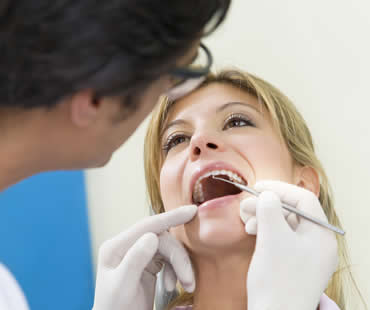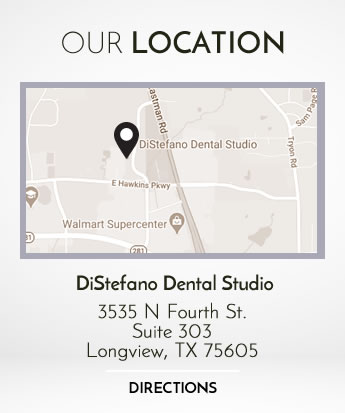
About 20 million Americans have been diagnosed with asthma, a long-term lung disease that causes swelling and narrowing of the airways. The condition has been linked to oral health, with patients having increased risk for cavities, gum problems, and bad breath.
One of the main culprits negatively impacting an asthma patient’s oral health is the medication required to treat the condition. Some medicines, such as corticosteroids, decrease the flow of saliva. This leads to dry mouth, which in turn can increase cavities and bad breath. Dry mouth is worsened by the fact that many asthma patients breathe through their mouth. Inhaled steroids can also increase the risk of thrush, which is caused by an overgrowth of yeast in the mouth.
Here are some tips for keeping your mouth safe while still controlling your asthma:
- Make sure your dentist is aware of your condition, as well as all medications that you are taking.
- Rinse your mouth with water or a fluoride mouthwash after using your inhaler.
- Consider using a spacer device with your inhaler, which will spray the medication directly into your throat and avoid some of the direct risks to your mouth.
- Bring your inhaler with you to dentist appointments, both to show it to your dentist and to have your medication available in case you experience an asthma attack at the office.
- Ask your dentist if more frequent dental visits are recommended in your case.
- Inquire about adding fluoride supplements to your routine, especially in areas where the water is not fluoridated.
- Maintain good brushing and flossing habits.
We look forward to seeing you in our Longview dental office

Brush and brush and brush, but you probably will not be able to get rid of all the plaque on your teeth. Even with regular brushing, some amount of plaque will build up on your teeth and turn into a hard substance called tartar. It simply can’t be removed without professional help.
What is tartar?
Tartar is a hard, yellow or brown deposit that forms on your teeth both above and below your gum line. Any food particles remaining in your mouth after eating will breed bacteria, which creates a thin film on your teeth called plaque. Any plaque that isn’t removed with brushing and flossing will harden to create tartar.
Is it harmful?
Tartar makes the surface of your teeth rough, which attracts food particles and therefore accelerates tartar formation. If you allow tartar to continue building up, your teeth will become discolored and your gums will be at risk. You will likely develop gingivitis, in which your gums become swollen and red. They will bleed easily and become painful, and eventually can lead to tooth loss. Advanced gum disease is even linked to higher risks of stroke, heart attack, and lung disease.
How is it removed?
Tartar is too hard and stubborn to be removed with regular brushing. The only effective way to eliminate tartar is by visiting your dentist and having it removed using professional equipment. This procedure is commonly called scaling.
Can I prevent tartar buildup?
Regular brushing at least twice daily with a fluoride toothpaste can help reduce tartar formation. Unfortunately, even with proper dental hygiene, plaque buildup is inevitable over time and will become tartar. Schedule regular checkups with your dentist to have professional cleanings performed.
If you live in the Longview area contact us today

The changing seasons can prompt many people to want to change their appearance, perhaps through treating themselves to a brand-new smile. Your dentist in Longview can provide a number of different cosmetic dentistry and restorative treatments to help provide a beautifully healthy and natural looking smile.
Cosmetic and Restorative Options
Modern dentistry techniques are extremely sophisticated and your dentist can do a lot to improve your smile. Possible options include porcelain veneers that cover the front surfaces of your teeth, crowns to restore teeth damaged by tooth decay or trauma, dental bonding that helps improve the shape of the tooth in just one easy visit, and enamel reshaping to correct minor issues such as slightly overlapping teeth. Dental implants can be used to replace missing teeth, transforming a gappy smile into something far more pleasing.
Teeth Whitening
Professional teeth whitening can quickly brighten up your smile, creating a youthful and healthy appearance. Your dentist in Longview can offer you in-office whitening that will lift the shade of your teeth in just an hour. If you prefer, you can have custom made whitening trays to use at home. Your dentist will provide you with the correct strength of whitening gel to safely bleach your teeth.
Teeth Straightening
It’s never too late to straighten your teeth and adult orthodontics is increasingly popular. Ask your dentist about Invisalign clear braces that will discreetly straighten your smile without really affecting day-to-day activities.
Checkups and Professional Cleanings
Your first step should be to schedule an appointment for a checkup and professional cleaning. Your dentist will need to examine your mouth to make sure your teeth and gums are healthy before carrying out any cosmetic dentistry treatments. They’ll discuss the type of options that might help you, and can compile a treatment plan to improve your smile. A professional cleaning removes tartar buildup and gives your smile an added sparkle. It’s a great treatment for keeping teeth and gums healthy.
We look forward to seeing you in our Longview dental office

Lots of people feel self-conscious about smiling, and problems with their teeth can make them hesitant to talk and laugh with others. Veneers are an easy way to transform teeth, and to get that gorgeous smile you’ve always wanted. Dental veneers are made from very thin pieces of porcelain or composite resin and fit tightly over the front surfaces of your teeth. They can mask many different types of imperfections and are a great way to improve the appearance of your smile.
In spite of this, veneers are not suitable for everyone. Your cosmetic dentist in Longview can help you decide if veneers are the best choice of treatment, or if another solution might be more appropriate. This procedure is not usually reversible so it’s important to be sure before your teeth are prepared for veneers. The following guidelines will help you determine if dental veneers are right for you.
Tooth Decay
Teeth that are decayed or which have already been filled are weaker and less able to support veneers. In this case you may be better off considering dental crowns that completely cover up decayed teeth right down to the gum line.
Gum Disease
You will need to have a full checkup with your dentist in Longview prior to having veneers. If you have any signs of gum disease then this condition must be treated first. It’s important to be in good oral health before your veneers are fitted.
Bad Oral Habits
Nail-biting, biting on ice cubes and teeth grinding can all damage veneers. If you have any of these habits then you’ll need to quit if you want your restorations to last.
Misaligned Teeth
If your teeth are quite crooked or misaligned, consider consulting an orthodontist to decide if braces are a better solution. It could be that once your teeth are straightened you’ll no longer need veneers. Dental veneers are not meant to correct severely misaligned or crooked teeth.

The desire for a better looking and better functioning smile has been around since ancient times. As early as 3000 BC, there is evidence that people used sticks to clean their teeth. Early toothbrushes were made of animal hair in the late 15th century.
The earliest forms of cosmetic dentistry are believed to be dentures made from ivory and bone by the Etruscans around 700 BCE. Other dentures were made from animal or even human teeth taken from corpses. Near 200 CE, the Etruscans had moved on to using gold to perform the functions of a dental crown or bridge.
Ancient Egyptians made a whitening toothpaste of vinegar and ground pumice stone, while the Romans utilized the ammonia from urine in their toothpastes, a practice that existed in some form into the 1700s.
Dental implants of human teeth were used in Europe in the 1700s for replacement teeth, but the practice was rejected due to repeated failures. Over the next hundred years, metal was used – and was also subsequently rejected.
The end of the 18th century and the entre 19th century showed great strides in cosmetic dentistry, particularly in the field of prosthetic dentistry, with the success of the porcelain denture. Molds were made of existing mouths with plaster, allowing dentists to provide the greatest denture fit and comfort available to patients thus far.
In the 1840s, the first rubberized material used as a base for dentures was invented, called Vulcanite. The first dental lab created specifically to produce prosthetic dental appliances was established in the 1850s. Porcelain dental crowns gave way to porcelain fused to metal crowns in the 1950s, and Vulcanite gave way to acrylic in the early 20th century, materials we still use today.
Your cosmetic dentist in Longview is a skilled professional whose techniques have been practiced and refined by those dentists who came before for thousands of years. Today, we are at the pinnacle of the knowledge and expertise of trained cosmetic dentists and with the variety of successful methods and materials that will work for any cosmetic need.
We look forward to seeing you in our Longview dental office

Not all dental procedures are extensive and invasive. Cosmetic dentistry offers many treatments to improve your smile that are relatively simple and require little time in the dental chair. If you have good overall oral health but are unhappy with your smile, you may want to consider some of these options for quick improvement.
Teeth whitening is one of the easiest and most popular cosmetic dental treatments for instantly improving the quality of your smile. Every day we expose our teeth to damaging and dulling foods and beverages that result in a dingy smile. Professional teeth whitening can whiten your teeth as much as ten shades in as little as one office visit, leaving you with a healthier and younger looking smile.
Dental bonding is an excellent way to repair small imperfections on teeth quickly, such as a discolored, chipped, or oddly shaped teeth. Bonding is essentially a simplified version of a veneer or a crown using tooth-colored resin to bond to the tooth and repair the problem. Bonding can usually be completed in a single visit to your dentist.
Many dentists are now offering snap-on teeth. A Snap-On Smile is a removable appliance that covers your natural teeth. The appliance uses your natural teeth to stay in place and does not require any additional adhesive to hold in place. A Snap-On Smile can be removed during sleep and for cleaning, but otherwise stays in your mouth for all of your usual activities. Patients with special needs, such as fear of the dentist or medical conditions which preclude extensive dental procedures, may also benefit from the use of snap-on teeth.
For more information about how to quickly and easily improve the look of your smile, schedule a consultation with cosmetic dentist Dr. DiStefano. It is easier than you may think to get that beautiful smile in no time!
If you live in the Longview area contact us today









